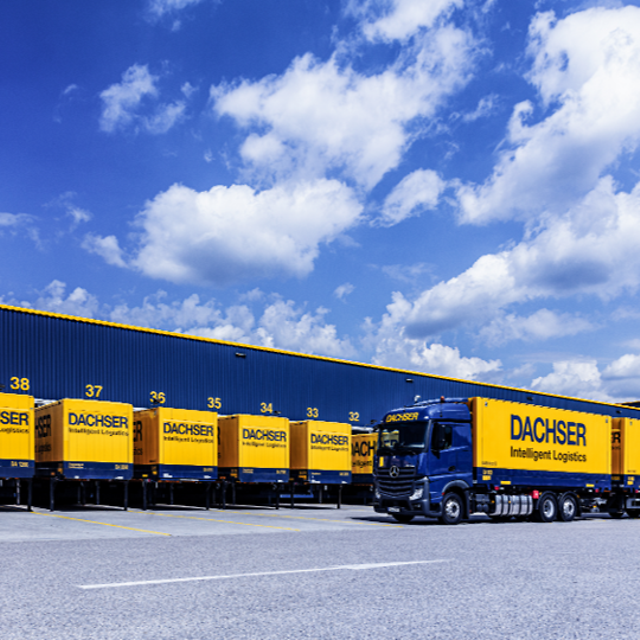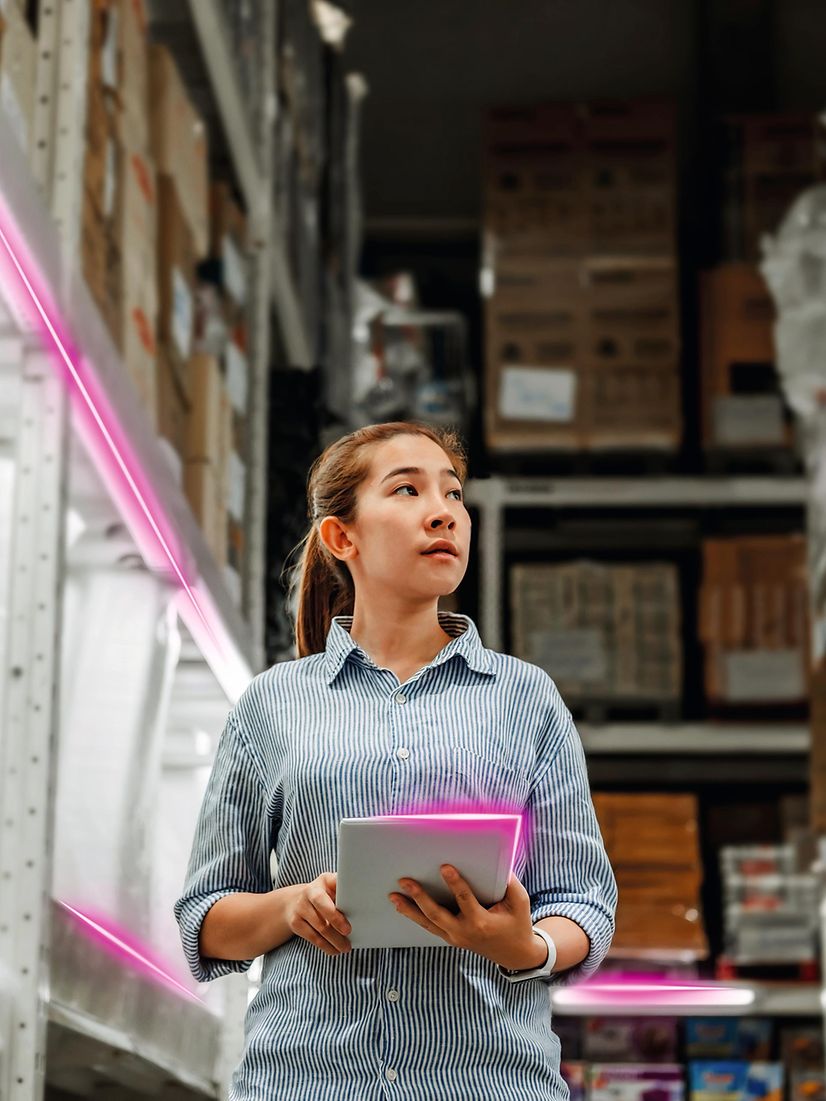Car2X - How modern technology contributes to greater road safety
Car2X ensures greater safety on the road and is ✓ connected ✓ predictive and ✓ driver-assisting. Find out more now.
Supply chains are becoming more complex, skilled operatives scarcer, and customers’ requirements are on the increase – in logistics as in so many other areas. How Dachser meets challenges of this kind by means of the Internet of Things.

From garden furniture for specialist retailers and engine parts for the automotive industry to garment racks on which to hang clothing for crease-free shipment (see box), the logistics service provider Dachser uses swap bodies to transport goods of all kinds by truck around Germany and Europe. The company has about 8,500 of them and uses them mainly to ship goods to its 237 European road logistics branches, where the standardized containers can be simply uncoupled from the truck, set down on folding support legs and later continue their journey on another truck. That is a definite advantage in that swap bodies, unlike semitrailers, are not limited to specific tractor units.
On the other hand, this operational flexibility has made real-time tracking of swap bodies across Europe a serious challenge. “Our customers’ requirements are on the increase. It is increasingly important for them to know exactly when the goods they want will arrive,” says Lars Relitz, Head of Corporate Digital Innovation & Development at Dachser.
To lay the groundwork for Europe-wide real-time tracking and even more efficient use of its swap bodies, Dachser wanted to connect them via the Internet of Things (IoT), to automate processes and by tracking to create greater transparency. Dachser’s R&D team joined forces with Telekom to tackle the issues.
The objective was clear: to establish a totally transparent supply chain. The two companies devised a multi-part solution that was rolled out in stages at Dachser. The first building block was the hardware: tracking modules supplied by Telekom partner Mecomo AG and incorporating high-end Telekom SIM cards with which Dachser equipped its swap bodies step by step. Existing units are being retrofitted and future units will come with SIM cards pre-installed. Connectivity was not Dachser’s only consideration in its choice of SIM card. High-end SIMs are especially robust and reliable. They function at temperatures ranging from -40°C to +105°C, an important aspect because Dachser trucks are on the road in wide-ranging weather conditions. The hardware must be just as reliable in an icy Norwegian winter as in a hot Spanish summer.
In addition, the service life of a high-end SIM covers the entire life cycle of a swap body. So the logistics provider does not need to worry about a regular SIM replacement, which makes processes even more efficient. Energy efficiency is another relevant aspect. The modules must be self-sufficient and not require a separate power supply. They come with a solar panel and a battery. The panel generates sustainable solar power and the battery has a storage capacity on which it can run for around six months. Even if the Sun does not shine for quite a while in the unit’s operating area its functionality is still assured.
Simply fill out the contact form – we’ll get back to you as soon as possible.
Connectivity also comes with energy efficiency, relying on the economical Low Power Wide Area (LPWA) standard LTE-M. For Dachser’s use case LTE-M is ideal because it ensures an uninterrupted data connection while the truck is on the move – another key issue in logistics. Connectivity is assured across the company’s entire European business area. If there is no Telekom LTE-M network coverage and no roaming agreement with a local provider, there will still be a GSM fallback connection.
The tracking modules relay their position to the Cloud and to Dachser’s transport management system at regular intervals via the cell network. There the company will in the future be able to manage, evaluate and visualize the data. It used only to know which goods were on which swap body; in the future their position will also be known. Telekom is providing Dachser with an online service portal to activate new SIM cards for additional tracking modules, for example. Thanks to motion sensors in the modules the data transmission frequency is adapted automatically to the situation. If a container is on the move, the hardware transmits position data at short, five-minute intervals. If the swap body is stationary for any length of time, data is only transmitted every six hours.
“The real-time tracking solution enables us not only to optimize our own processes but also to offer our customers more transparency.”
– Lars Relitz, Head of Corporate Digital Innovation & Development at Dachser
In the next step Dachser rolled out the IoT solution and the visual data processing software across the company. The idea of a transparent supply chain is now a reality at Dachser. Every branch in its European network is connected to the Cloud platform and the data is available so that every site has an optimal overview of the company’s swap bodies and can deploy them more efficiently.
The ability to forecast a shipment’s time of arrival precisely thanks to real-time position data is a great advantage. Local delivery vehicles at the distribution centers no longer need to wait for goods that will not arrive until much later than originally scheduled because, say, a truck is held up in unexpected traffic congestion. “Thanks to automation we can implement proactive monitoring: we see in the system when there are problems with individual units and can react accordingly,” Relitz says. In such cases local drivers can use their storage capacity for other deliveries that are available and embark on delivery both punctually and fully laden. That not only optimizes processes and keeps the supply chain lean; it also eliminates empty parking lots and additional journeys, reducing CO2 emissions. Dachser had, after all, hoped the IoT solution might improve its sustainability. The automated tracking solution will certainly enable it to deliver the transparency that customers are increasingly demanding – along with clear estimated time of arrival statements.
Another use case Dachser is implementing jointly with Telekom demonstrates how flexibly tracking solutions can be used in logistics. It involves connecting the clothing racks used by garment manufacturers to enable clothing to be delivered crease-free to shopping outlets. It was not always easy to keep an eye on them all, so Telekom and Dachser fitted them out with a Low Cost Tracker Plus. Much like the tracking modules on the swap bodies, the Low Cost Tracker Plus sends position data at regular intervals via the IoT to the Cloud, but using Narrowband IoT (NB-IoT) rather than LTE-M. In this instance Dachser is less interested in tracking the racks en route than in efficient stock management.

With Deutsche Telekom's Low Cost Tracker, you can keep an eye on containers, pallets and machines at all times. Up to 5 years of battery life, precise location and real-time data – for more efficiency, less losses and smart processes.

Back in 2016, Anna worked on IoT topics at Deutsche Telekom for the first time. Since then, she has been supporting customer best practices in a wide range of industries – always focusing on the benefits that the Internet of Things can provide. Her IoT blogposts describe real use cases and the value these innovations add to market players, their business models, and even entire industries.
Car2X ensures greater safety on the road and is ✓ connected ✓ predictive and ✓ driver-assisting. Find out more now.
Read article
Supply chain transparency is a crucial success factor today. Given complex risks and new laws (like the Supply Chain Due Diligence Act), companies must track their supply chains seamlessly. Telekom's IoT solutions provide the technological foundation for this: Through intelligent connectivity, sensor technology, and data analytics, they enable real-time visibility and control. Learn more in this article.
Read article
Telematics is now much more than just a technical term. It is a key technology that is already helping numerous companies from different sectors to maintain an overview and optimise processes. In this article, you can find out how telematics works and in which sectors it is already being used. Find out more in this blog article!
Read article